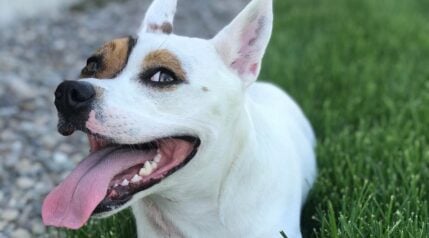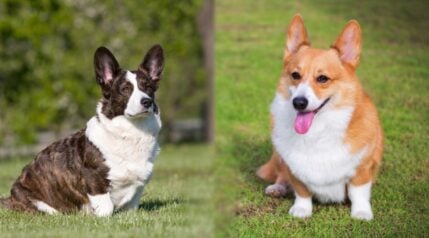As far as designer dogs go, the Corgi Pug mix may seem a little unconventional. After all, what do you get when you combine two short, slightly goofy pups?
Actually, the result of these adorable breeds may be cuter than could imagine, and their personality sure packs a punch of its own. Mixed breed pups can be a shot in the dark, but overall most pups inherit the breed traits coming down through their parents.
While this mix is on the newer side of the breeding chart, its parent breeds have extensive, rich histories that significantly contribute to the Corgi Pug personality. Corgis are becoming more and more popular as being the “other half” of other designer dog breeds, like the Horgi and the Corgidor.
Let’s take a more in depth look at the two dogs, as well as what you can expect when you adopt a Porgi.
The Basics
As you can probably tell from its name, the Corgi Pug mix is a cross breed of the Pembroke Welsh Corgi and the Pug. Both small breeds, the result of mixing the two is an equally as small, possibly much more adorable blend of playfulness, goofiness, and friendliness.
Known for their companionship, both of these breeds have different backgrounds but similar purposes. This short and stout breed is a mix of two very popular breeds, the Corgi placing at number 15 and the Pug at number 31.
Often referred to as the Porgi, the Corgi Pug mix draws its trait from its two parent breeds, so it’s important to learn more about the Corgi and the Pug before getting deeper into the mix.
Pembroke Welsh Corgi
The Pembroke Welsh Corgi originated in Pembrokeshire, Wales, where it received its name. Despite their cute corgi butts, stout bodies and short legs, Corgis were working dogs often used on farms to herd cattle, sheep, and horses.
These pups are very intelligent and eager to learn with a great willingness to please their masters. They are highly active, which was why they were great at their herding job. Because of their energy level, Corgis need a lot of exercise and play time.
While highly intelligent, Corgis do have a tendency to be stubborn. Of course, like with most dogs, you can combat this problem with consistent and strict training early on. They are also very vocal dogs who tend to bark at anything.
Pembrokes make great family pets, as they portray a demeanor of happiness, love, and affection. While they are easy to train, they are also very independent and often think for themselves. Food and treats make excellent tools when training Corgis, as they love to eat. Watch how much you give them, though; they are also prone to obesity and overeating.
Pembroke Corgis are friendly; however, without proper socialization, they can be a bit wary of strangers. Their suspicion makes them good watchdogs, but keeping them social will make them much more well-rounded.
You can expect a Pembroke Corgi to be around 10 to 12 inches tall and no more than 30 pounds.
Pugs
Pugs, like Corgis, are very smart dogs with big hearts. These lovable pups are a part of the toy group. Though they are similar in size, Pugs come from a very different part of the world. This breed was originally popular in China and date as far back as 206 B.C. They are one of three short-nosed pups bred by the Chinese.
Unlike the working Corgi, Pugs were seen as prized possessions, owned by emperors along with rich, luxurious families. During their earliest appearances, they were sometimes viewed as important enough to have their own guards.
As the breed’s popularity grew throughout the world, the Pug became a popular breed in the royalty of Europe. Many princes, kings, and queens owned this breed. When the breed finally came to America after the Civil War, it was very popular. Its popularity dropped a little but quickly picked back up after continued breeding.
Pugs are known companions. They adore affection and make great lap dogs. While they may not learn cool tricks, help you hunt, or guard your home, they will steal your heart and share your bed.
You will often find yourself laughing at your little pug, as they tend to be a bit goofy and very playful. In fact, he probably entertains himself quite nicely. That being said, he will love to play with you just as much.
Pugs tend to keep the personality they have as a puppy, so it’s important to look at a litter thoroughly before you choose your pup. As an adult, he will be no more than 18 pounds and will grow to be about 10 to 14 inches tall with short, double coats.
Physical Traits
Porgis tend to combine the best of both worlds in physical traits. These breeds make a good match considering their similar size, which makes it easier to guestimate the mixed size. Similar to the Beagi, a Corgi Pug mix will typically be between 10 and 13 inches high.
The weight difference between the parent breeds is much different than the height, so that will be a varying trait among mixed pups. Adult Porgis can be anywhere from 18 to 30 pounds.
When it comes to physical appearance, most Porgis take on the light, fawn coloring of a Pug along with its dark muzzle. The size of its head and muzzle will likely land somewhere between the two breeds, with the possibility of a flat face, while the build leans more towards a Corgi.
As a cute bonus, the Porgis ears tend to flop over rather than stand up straight, and they tend to boast the curly tail of a Pug but with the fluffiness of a Corgi.
These mixed dogs will have a short and straight yet dense coat. Their coloring can be fawn, black, red, and brown.
Grooming
Though they have short hair, Porgis are known to shed heavily. Daily brushing helps to remove loose hair along with any existing dirt or debris. The best brushes to use for this mixed breed are pin brushes, slicker brushes, and de-shedders.
Although regular grooming is best for these pups, they generally do not tend to take on strong odors, so bathing can be kept to a minimum.
Other regular grooming can include cleaning out their ears and keeping their nails clipped. Do not expect excessive drooling from a Porgi, either.
Exercise
Porgis are dogs with moderate energy levels. While they do need daily exercise along with mental stimulation, they aren’t as high maintenance as more active dogs. As long as they can get out of the house for a walk or to run around the backyard once a day, they should be happy.
You can even get away with indoor exercise on days when the weather is bad, or you just don’t have the time for a long walk. As long as they get a little movement in, they’ll be good to go. Without some attention and exercise, your Porgi may develop poor behavioral habits.
Nutrition
Since both the Corgi and the Pug are known for their love of food, it’s no surprise that the hybrid mix enjoys it equally as much. Because of this fact, it’s important to monitor your Porgi’s diet strictly and stick to a regular feeding schedule.
Corgis are additionally prone to obesity, and that trait can certainly play a factor in your mixed pup. If there is food out, your Porgi will eat it. While some pet owners like to leave food out all day for their dog, this shouldn’t be your practice for the Corgi Pug mix.
As long as their feeding is consistent along with their exercise habits, there shouldn’t be too much to worry about.
Health
In terms of health risks, the best thing you can do for a hybrid breed is take a look at the risks involved with their parent breeds.
Corgis are known to have a high-risk level of hip dysplasia. Additionally, due to their short legs and long bodies, they are prone to back and spinal issues. They can also overeat and therefore, may deal with obesity.
Pugs often develop breathing problems. They can also be at high risk for eye conditions.
Though breeding these two dogs lowers the health risk for your Porgi, it is still essential to do your research, obtain detailed health records of the parents, and take your pup for tests and regular vet visits.
Personality
Porgis tend to be very loving, very loyal, and very attached dogs. They make excellent companions who always want to be by your side. While this is certainly a positive trait, it can have its downsides.
You may find that your Porgi has separation anxiety. For this reason, it’s important for families with Porgis to be home frequently and be able to spend time with their precious pet. A Porgi will likely not do very well in a home that is empty for hours at a time.
Because of their Corgi background, Corgi Pug mixes can sometimes take on traits of herding instincts. These instincts often lead to the dog feeling that they must protect their families like a flock. In terms of loyalty, this is a good thing. However, it can lead to issues with young children and the tendency to nip at their heels.
When properly trained, you can certainly avoid this issue—though it may be safest to get this pup only in a household with older children.
Porgis are very affectionate. It can be very friendly towards strangers, but probably won’t let them approach without a few warning barks. Early socialization can help with any stress or anxiety this mix breed may take on naturally.
Training
Though both of the parent breeds of the Porgi are very smart, loving, and eager to please, your mixed pup may have picked up traits of stubbornness and independence from the Corgi half as well as mischievousness from the Pug half.
These personality traits can make training a little more difficult than you anticipated. However, it’s definitely not impossible, especially given a Porgi’s natural desire to please and affection for its master.
The best way to train these pups is to start early, remain consistent, and show a lot of love. Since they love affection, they will respond well to your praise and lots of pets when they do the right thing and learn a new command.
Frequently Asked Questions
It’s normal for new and experienced dog owners alike to have a few questions about specific breeds they are interested in. In fact, many of these questions are common among most people. Check out our FAQ section to find a few typical questions about Corgi Pugs and their answers.
Q: How long do Corgi Pugs live?
A: With proper care, feeding, and exercise, you Porgi can live a long, happy life of up to 15 years. This is the average life expectancy of both the Corgi and the Pug, and as long as you take care of them, there’s no reason why they shouldn’t be in your life for as long as its parent breeds.
Q: How much do Corgi Pugs cost?
A: The average cost of a Corgi Pug will typically be around $700 to $1,000. While that may seem high, it’s important to remember that not only are both of the parent breeds very popular, but a reputable breeder will ensure that your puppy was bred carefully and is healthy.
However, the price can fluctuate based on the breeder’s purpose for making these puppies. Those who are breeding for show and competition can cost well over $1,000.
Q: Do Corgi Pugs bark a lot?
A: No! Corgi Pugs actually have a very low tendency for barking. The only time you will typically hear them speaking is when they feel the need to sound an alarm. This could be when someone is approaching your house or if they feel threatened by something. But on a regular basis, a Corgi Pug will usually be pretty quiet.
Final Thoughts
If you have a thing for short, stout, adorable puppies, then the Corgi Pug mix might be exactly the breed you need in your life. As an owner of this mix, you need to remember to stay tough but loving through the training stage. With a good amount of effort and lots of praise and snuggles, you can have yourself a loyal, yet slightly goofy, companion for a long time.






I have had 2 pugs in the past. I also had a neighbor who had a corgi. It’s not hard to imagine how
I have had my corgi/pug for 16 years now and he still acts like a puppy!
Sounds like an amazing dog, Carolyn! Thanks for stopping by to comment!